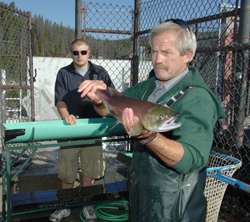forum
library
tutorial
contact

Hundreds of Sockeye Return Home
by Jason KauffmanIdaho Mountain Express, August 19, 2009
|
the film forum library tutorial contact |

|
Hundreds of Sockeye Return Homeby Jason KauffmanIdaho Mountain Express, August 19, 2009 |
452 'red fish' have arrived in Sawtooth Valley this summer
 For the second summer in a row, hundreds of sockeye salmon are pouring into the upper reaches of the Salmon River near Stanley. Their final destination is the Redfish Lake area, in the eastern shadow of the ragged crest of the Sawtooth Mountains.
For the second summer in a row, hundreds of sockeye salmon are pouring into the upper reaches of the Salmon River near Stanley. Their final destination is the Redfish Lake area, in the eastern shadow of the ragged crest of the Sawtooth Mountains.
Altogether, 452 of the "red fish" have arrived at either of two fish traps located on the Salmon River at the Sawtooth Fish Hatchery or near the mouth of Redfish Lake Creek.
The back-to-back positive returns of the iconic fish of the Sawtooth Valley is largely the result of increased smolt production at the Idaho Department of Fish and Game's captive rearing program. Positive river flows and good ocean conditions have also given the fish a boost in recent years. Last summer, 636 of the fish--sporting the classic green head and red-bodied look of spawning sockeye--arrived home to the high-elevation valley.
The first two sockeye of the 2009 season arrived in the Sawtooth Valley in late July.
The two runs more than surpass the recent high of 257 sockeye that came back in 2000, which was the next highest return since 1985. And it's far more than the four sockeye that came back in 2007. Between 1991 and 1998, a total of just 16 sockeye returned to Redfish Lake.
The historic declines in the fish are tied to over-fishing, mining, poisoning in the early days and, perhaps most significantly, a dam-building boom on the Columbia and lower Snake rivers between 1937 and 1975.
On Tuesday, Dan Baker, hatchery manager at the Eagle Fish Hatchery, headquarters for the state's captive breeding program for Redfish Lake sockeye, predicted that as many as 650 to 700 sockeye will have arrived in the Stanley area by the end of summer. Baker said the last fish will likely arrive sometime around the beginning of September.
During the past few springs, Idaho's hatchery program has released between 150,000 and 175,000 sockeye smolts. The young fish are kept in captivity as long as possible to give them a better chance of surviving the long voyage down the Salmon, Snake and Columbia rivers to the ocean.
"They're released directly to Redfish Lake Creek or the Salmon River," Baker said.
Redfish Lake sockeye (Oncorhynchus nerka) were listed as endangered under the federal Endangered Species Act in November 1991. Historically, up to 30,000 sockeye spawned in the Sawtooth Valley's Alturas, Pettit, Yellowbelly, Redfish and Stanley lakes.
The fish were the first Idaho salmon to be listed under the ESA. Redfish Lake sockeye are unequaled in that they travel to the highest elevation, over 6,500 feet, run the longest distance, about 900 miles, and travel the farthest south of any North American sockeye population.
Idaho fisheries biologists hope that eventually, as many as 2,000 sockeye born from fish allowed to spawn naturally in Redfish Lake will migrate back to the Sawtooth Valley each summer. So far this summer, 69 sockeye born from natural spawners have returned.
Recovery, it seems, is still a long way off.
But that doesn't mean that fisheries biologists aren't excited by the successes they've seen two years running. Baker said future expansions to the state's captive breeding program should allow even more sockeye to come home each year.
"It's very rewarding to see this fish come back," he said.
Related Pages:
Count the Fish
learn more on topics covered in the film
see the video
read the script
learn the songs
discussion forum
